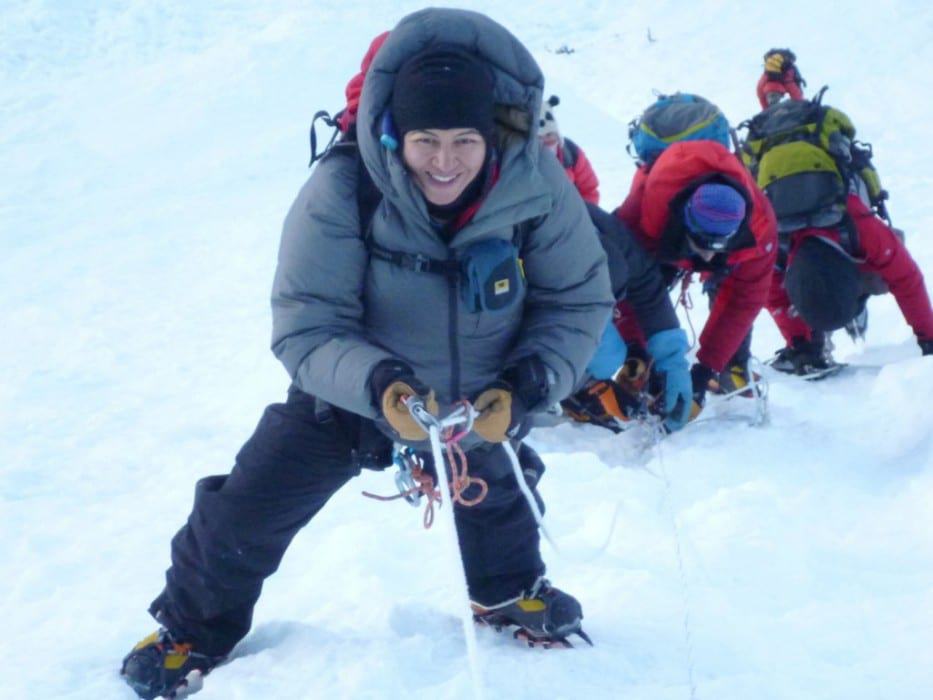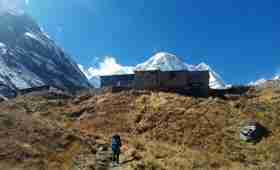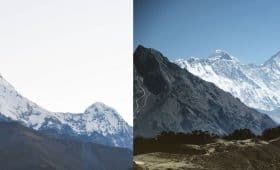Whether you are planning an expedition to test your physical and mental abilities or crossing another of the world’s highest peaks off your list, Island peak climbing in Nepal is one mountaineering destination that’s worth considering.
It is one of the most highly sought after peaks in the world. And is an excellent introduction to high altitude mountaineering, climbing Island Peak is recommended for climbers who want to reach higher Himalayan peaks and witness excellent views from its top.
Located in the picturesque Imja Valley on the Everest region and standing at 6,189 meters (20,305 ft) above sea level, this expedition to reach top of Island Peak offers spectacular scenery of the Himalayas.
On its summit ridge, the view is spectacular with the 360-degree panorama of the many Himalayan mountains: Nuptse, Lhotse, Lhotse Shar and Lhotse Middle Peak on the north, Makalu on the east and Ama Dablam and Baruntseon the south.
But like reaching any Himalayan peak, getting to the summit of Island Peak is not for the faint of heart.
It is an expedition that requires oodles of preparation and respect. But we’ve got you covered, with the following tips to conquer Island Peak.
Want more information? Send us your query, and our experts will get back to you within 24 hrs.
Table of Contents
- Tips on Climbing Island Peak
- 1. Train for Steep Hiking and Abseiling
- 2. Prepare for Himalayan Temperature
- 3. Have the Right Acclimatization Schedule
- 4. Hire an Experienced, Qualified and Professional Guide
- 5. Train in Your Mountaineering Boots Early
- 6. Come Prepared with the Right Gear
- 7. Most Importantly, Have Altitude Experience Before Your Island Peak Hike
Tips on Climbing Island Peak
1. Train for Steep Hiking and Abseiling

Island Peak is a steep hike to 20,305 ft. You will find yourself climbing steep rocky scree, crossing a glacier and hiking a steep headwall all the way the mountain’s summit.
Moreover, you will also have to walk for at least 11 days (at least 6 hours of walking per day) to Everest Base Camp (EBC), which is strenuous in itself. Needless to say, endurance is crucial to your success in this expedition.
We suggest that you take a training program for hiking and steep climbing with weights to build your endurance before your Island Peak adventure. It is also essential to be proficient with abseiling.
The hike to the summit can be difficult even for the well-prepared mountaineers. But it is doable and you will enjoy the climb if you take proper training.
2. Prepare for Himalayan Temperature
Don’t underestimate the Himalayan temperature. Going up there, it can get really cold so it is essential that you get accustomed to that temperature while hiking.
In winter, expect a temperature of around -20 C or so near and at the summit range, not to mention the wind-chill effect that can make the Island Peak climbing even more challenging.
The good thing is you can always take a Winter Skills course, which can be done around the world, a few months before your trek. In the United States, one of the best places to take a Winter Skills course is on Mt. Rainer.
3. Have the Right Acclimatization Schedule
As it’s always said in any of Himalayan treks, altitude is no laughing matter and it can strike anyone regardless of your fitness level.
This is most especially true in expeditions such as Island Peak Climbing via Everest Base Camp, to over 20,000 ft.
If altitude issues have stricken thousands of mountaineers trekking only to EBC, expect more of such issues in this adventure. So neutralizing the effects of altitude, by involving in proper acclimatization, is crucial to your success.
Make sure to have a proper acclimatization schedule and sufficient training in Namche Bazaar, then in Dingboche and Island Peak Base Camp.
Remember that altitude needs to be respected, not forced, so take your time and spend more time acclimating if needed. That’s one way to beat altitude and be able to reach your goal of climbing Island Peak.
4. Hire an Experienced, Qualified and Professional Guide

While you may just go ahead and may take the trek to EBC without hiring a guide (that is if you had taken this trek a few times before).
We highly suggest you have a guide or a qualified tour company to take care of you on your Island Peak climbing.
Unlike Everest Base Camp trek that is usually crowded during the season, Island Peak is a more off-the-beaten-track, attracting only the most experienced climbers who are brave enough to take up more challenges and obstacles.
Having a guide that is qualified /licensed, experienced or trained in this endeavor ensures not only your safety but also success in reaching your goal.
An experienced guide from Mosaic Adventure is not only trained in hiking steep mountains but will also safeguard you from hazards in this journey, such as landslide regions, yak or drop-offs.
Our guide will motivate you to climb safely through the trail and will always be on the lookout for hazards for your safety.
5. Train in Your Mountaineering Boots Early
 One of your most indispensable and most important mountaineering gear is your boots. Mountaineering boots are heavier than your normal hiking boots and are extremely rigid, making them more difficult to walk in.
One of your most indispensable and most important mountaineering gear is your boots. Mountaineering boots are heavier than your normal hiking boots and are extremely rigid, making them more difficult to walk in.
NEVER make the mistake of buying a pair just a few days before your hike and test out your boots in the actual hike itself.
Remember that your feet are very important to your success here, so make sure that you don’t only get the right pair but have also tried or worn-in your boots before you go to ensure your convenience while hiking.
It is also good to train with your mountaineering boots along with weights to get you accustomed to the actual hike.
6. Come Prepared with the Right Gear
Having the right gear can make or break your success in conquering Island Peak.
Once you arrive in Island Base Camp, there are no lodges such as along the trail to EBC. So, you will be sleeping in tents out in the elements, with temperature ranging from +20 to -15C or lower.
Some of the most essential pieces of gear to have for the expedition include high quality down coat and a high-quality base layer made of wool to keep you warn most especially in the evenings and during your summit attempt.
Having a quality sleeping bag and sleeping pad designed for extremely low temperatures is also essential, along with gloves, bandana, wool hat and balaclava.
Important mountaineering equipment includes carabiners, crampons, ice ax, and rope.
For a full list of Island Peak essential gears, contact us. We can also recommend places where you can rent high-quality mountaineering equipment in Nepal.

7. Most Importantly, Have Altitude Experience Before Your Island Peak Hike
Remember that you will be making a massive investment in this expedition in terms of time and money. The problem is that altitude is the biggest unknown factor in this adventure and every person reacts to altitude differently.
Hence, we strongly advise anyone to have an altitude experience before taking this trek.
While having enough acclimatization schedules is important, it is also equally important to test yourself first in high altitude by taking relatively easier treks such as EBC.
This allows you to get the feel of how altitude affects you and to know how much acclimatizing and preparations you need to successfully complete your Island Peak mission.
Indeed, successfully completing Island Peak Climbing means hard work, endurance and knowledge.
But, being able to conquer this Himalayan peak will not only reward you with divine views only limited to those who brave them, but also with unique experiences only shared by the world’s bravest mountaineers.
For more tips on how to conquer Island Peak or to plan for your perfect Island Peak Adventure, contact Mosaic Adventure.
With our years of experience in an expedition to Island Peak, we can guarantee you to have a trip of a lifetime with us.
Not to forget, you can also opt for Mera Peak climbing in the same region if you wish to.
Want more information? Send us your query, and our experts will get back to you within 24 hrs.

Madhav started working as a porter in 2001 and then moved on to work as a trekking guide. After working in the trekking and tourism industry for eight years, he co-founded Mosaic Adventure in 2009.
Madhav has trekked to most of the trekking destinations in Nepal, including Everest Base Camp Trek, Annapurna Base Camp, Annapurna Circuit Trek, Poon Hill Trek, Jomsom Muktinath Trek, Indigenous Peoples Trek, Langtang Valley Trek, Mardi Himal Trek, and all of the day hikes around Kathmandu.
He has also extensively traveled to other countries such as Australia, the USA, the UK, France, Hong Kong, Japan, China, the Philippines, the UAE, Saudi Arabia, Bahrain, Thailand, Turkey, and India. Madhav is the one who answers most of your questions about trekking and tours and helps to plan your trip by giving a personal touch.




